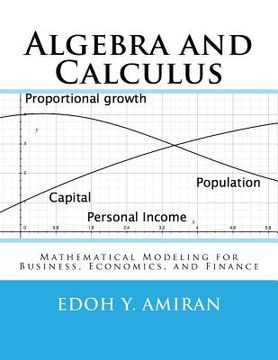Algebra and Calculus: Mathematical Modeling for Business, Economics, and Finance (en Inglés)
Reseña del libro "Algebra and Calculus: Mathematical Modeling for Business, Economics, and Finance (en Inglés)"
This text introduces basic ideas in both the language (mathematics) and its use (economics, finance, and decisions). In order to motivate students and meet the demands of the applications, we concentrate on applications motivated by questions that a curious reader would ask. We also concentrate on applications which can be started with a minimal mathematical background and developed more fully throughout the text, providing continuity for the reader. This continuity serves two purposes. One is to provide a familiar setting in which we add new questions and discuss new ideas, and the second is to provide a periodic review of the facts and techniques presented earlier. In order to meet the time constraints of the course, we explain some of the mathematical techniques using applications, thus delaying the need for the full mathematical background. We introduce topics of interest and explain their importance and implications first. Concepts from economics and finance and from mathematics are introduced together in the context of an example or topic that has already been discussed. Some of the topics introduced include data, many examples are hypothetical or heuristic. All topics are ones in which there is real interest - none of the examples are artificial in that they present an intellectual approach or technique that professionals would avoid. This means that techniques are naturally integrated into discussions, following a modeling tradition. However, since this text is introductory, we do not assume that the reader is already familiar with the context. Rather, we use the topics as a means for promoting critical thinking and involving the reader in the practice of mathematical, financial, and economic modeling techniques. Another consequence of this approach is that different modeling and calculation techniques - symbolic, graphic, schematic, verbal, and numerical - appear naturally in various examples. Deciding on a technical approach forms part of effective thinking and analysis, and we offer a wide array of examples so that the reader can learn which techniques are most effective in understanding different ideas and which techniques work best for the particular reader. When a topic is introduced we first make sure that the meaning is clear, and only then develop the tools commonly used for analysis. Thus a student can always interpret results, not just follow procedures that produce a formal answer. In practical terms, this means that some concepts are introduced and explored numerically, organized graphically, and then analyzed symbolically. We include review sections in some chapters to clarify and emphasize the meaning of variables and calculations. For students with more time, or a deeper interest in theory, we include projects and exercises that explain the mathematical techniques and explore some parts of the theory. This text aims at a relatively stable level of sophistication, while repeatedly increasing the level of complexity. When students are expected to understand a certain issue, such as the possibility that a maximum occurs at an endpoint, the issue is illustrated in the main set of examples on the topic. This avoids students getting used to solving problems mechanically and later being surprised by learning that what they have been doing is incomplete or incorrect.

